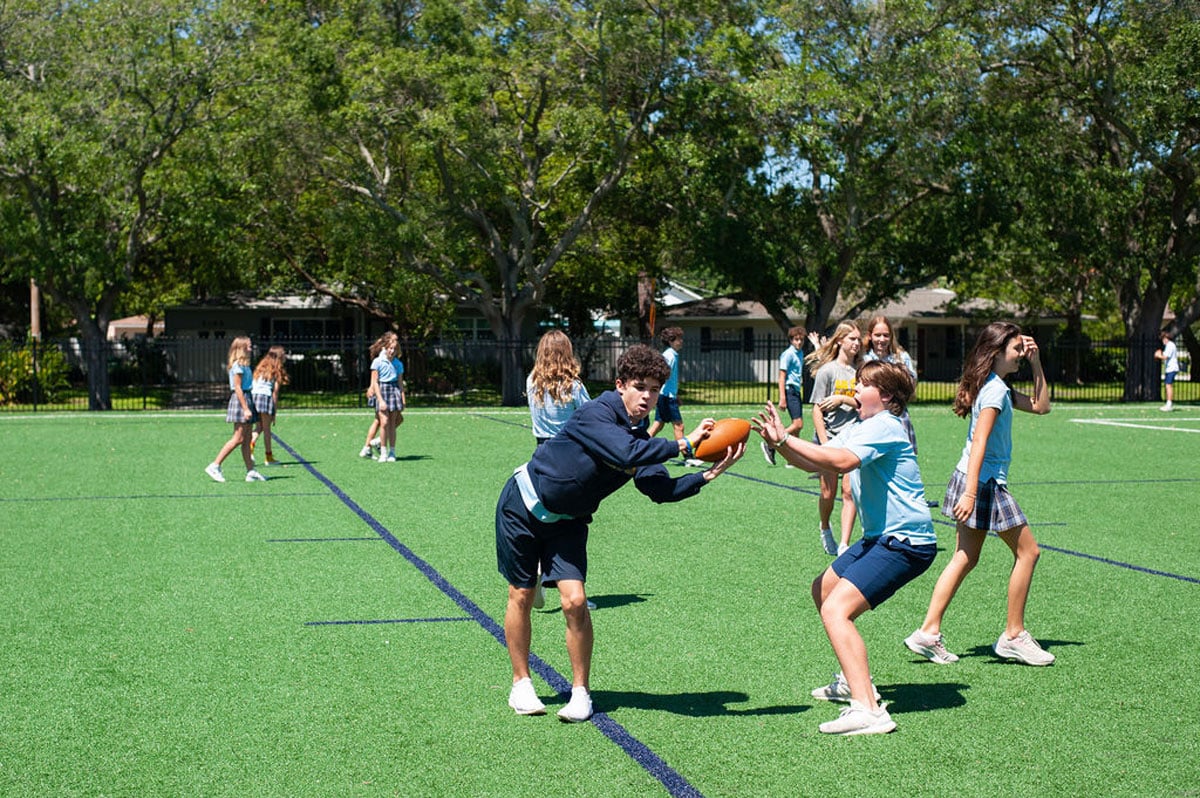Beyond the Classroom
Enriching the Whole Student
St. Mary's strives to develop the whole student through comprehensive co-curricular enrichment classes, activities, and athletics. Students embark on a journey of self-discovery, identifying their unique strengths and interests through exposure to a variety of intellectual, physical, and artistic pursuits.
We seek to balance excellence in all these areas with spiritual growth and guidance, so our students develop moral courage and personal integrity. These courses take place during the school day and are made available to all students.






Enrichment Classes |
Optional Extra-Curricular activities |
|
Visual Arts Music Performing Arts STEM Religious Studies Physical Education Library World Languages - Spanish and Latin
|
Competitive Athletics Yearbook Staff Video Production Debate Team Student Government Community Council Student Ambassadors Saintly Strings Concert Band Drumline Choir Acolytes Chess Club |
Art
Students in all grades work with a variety of art media and technology to create 2D and 3D artwork. They also have an opportunity to learn about artists based on our school-wide global theme, and study art throughout history and different cultures. Additionally, field trips to local museums help broaden students’ appreciation for art.
Middle school students look forward to printmaking on a press, mixed media projects, art appreciation games and research projects, and digital art with iPads and Apple Pencils. St. Mary’s 8th grade students also have the opportunity to expand their art experience by choosing Pre-AP Visual Art, a high school level exploratory art course, as one of their electives
Students are able to exhibit their artwork throughout campus in various galleries. Students selected to showcase their art are also featured in the school’s literary magazine, Bold, within the yearbook.
All students have their artwork displayed during St. Mary’s annual Fine Arts Night in the spring. This special event showcases the school’s fine arts program throughout campus.
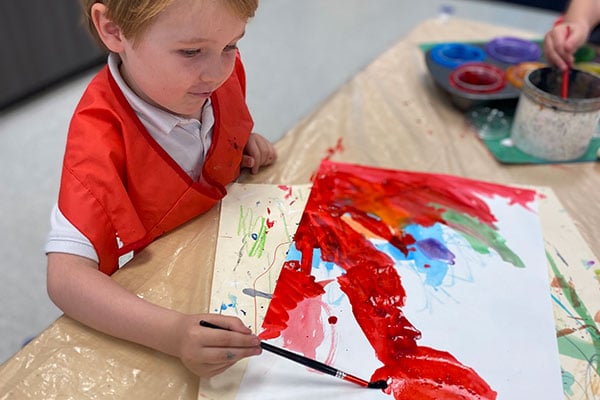
WORLD LanguageS
In PreKindergarten through third grade, our students are immediately immersed in hearing and speaking Spanish. They recite poetry, listen to stories, sing songs, and move their bodies to music, all activities which keep them engaged and learning. We focus on a variety of common daily topics in order to build the skills needed for productive conversation in the current environment. The lower grades receive instruction on basic grammatical concepts, and a scaffolding approach is used to reinforce those concepts with reviews, where the children use practice activities to put their knowledge to work on their own or in groups. As students move through PreK - third grade, they first hear and speak Spanish, then they begin to read written words, sentences, and paragraphs, and finally begin the basic writing process so the transition to fourth grade is seamless.
In fourth grade, students begin the transition into a more grammar-based curriculum. There is a strong focus on the Spanish phonetic system, spelling, basic subject/verb reciprocity, forming sentences, and asking questions. Our fourth graders learn through a variety of games, songs, and activities. The fifth grade curriculum becomes more academic as it expands upon the phonetics, grammar, and vocabulary mastered in fourth grade with a greater emphasis on speaking, writing, and oral communication. Our fifth graders also explore the geography, culture, celebrations, and music of various Spanish-speaking countries. Spanish is used as the language of instruction for both fourth and fifth grades.
After completing a year of sixth grade Latin, students will commit to either Spanish or Latin for seventh and eighth grade.
Students who choose Spanish will complete the equivalent of a high school Spanish I class by the end of their eighth grade year, and are prepared to move into Spanish II as high school freshmen. Both seventh and eighth grade curriculum is taught primarily in Spanish. During these two years, the students travel through units and lessons dedicated to vocabulary topics, dictation, and listening activities relevant to their current real world experiences. Grammar includes various tenses, regular, irregular, and reflexive verbs, as well as challenging stem- changing conjugations. The students apply their skills to speaking, writing, and reading comprehension. The goal of our middle school Spanish program is to develop communication skills that lead to written and oral fluency.
In sixth grade, all students are required to take Latin and are introduced to the language and ancient Greek and Roman civilization. Students learn vocabulary and basic grammar concepts, including noun inflection, subject-verb agreement, and verb conjugation. Emphasis is placed on how English words are derived from Latin words. There is an auditory component in the study of this “dead” language. Students also read stories from Greek and Roman mythology.
In seventh grade, students who choose Latin begin a two-year course. Along with vocabulary and derivatives, students learn essential grammar concepts, including noun declension and case usage, verb conjugation, tense and voice, and how Latin sentences are structured. The primary objective is to build skill in reading Latin. Other objectives include strengthening English grammar and vocabulary, learning concepts transferable to the study of modern languages, acquiring familiarity with ancient Roman civilization and sharpening analytical skills. Students have the opportunity to compete in annual contests, both locally and nationally. This class continues through eighth grade and is equivalent to Latin I at the high school level.
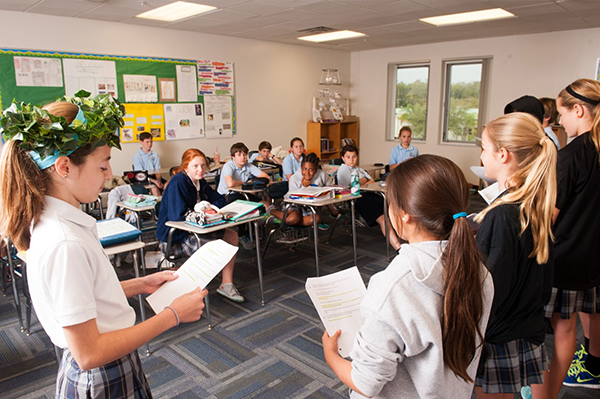
Music
Music at St. Mary's is hands-on, imaginative, and filled with song, dance, instruments, fantasy, and fun!
Students in 1st through 3rd grade, together with 4th and 5th grade present a Christmas Concert along with all instrumental groups. Pre-K through 4th, along with 6th grade and ensembles participate in a Spring Concert. 3rd through 6th graders audition for the Spring Musical held in May at our Fine Arts Night. 7th grade presents a Variety Show in the spring. 8th grade presents a full-scale musical in the fall.
Our Saintly Strings program is available to all second through eighth grade students interested in playing the violin. Middle school students may also elect to play the cello or viola. Strings classes are part of the school day with an optional all-grades group class on Fridays after school. Saintly Strings is an excellent way to develop musical skills while enjoying a variety of performance opportunities throughout the year.
Strings Director: Ms. Hensley
The Flex ensemble is an elective class for 7th and 8th grade students who have experience playing a musical instrument or singing. This advanced ensemble performs at many different events throughout the year.
Flex Ensemble: Mr. Craig
Praise Band is offered to students who are in 6th-8th grade. Students have the choice to play these instruments: acoustic guitar, keyboard, bass guitar, drum set, and vocals. Practices are once a week, and performances are in the Chapel once or twice a month.
Praise Band Leaders:
Mr. Murphy, Mrs. Cosentino, Mr. Craig, and Ms. Hensley
Choir is offered to students in first through sixth grade, and practices are held once a week before school starts. The Choir performs at various chapels, assemblies, and the spring Fine Arts Night.
Choir Director: Mr. Craig
The Saints' Drumline is offered to students who are in 4th-8th grade.
The Drumline performs in school assemblies, pep rallies, and for the opening ceremony on Field Day. The Drumline has two major performances: a First Semester Performance in December and a Second Semester Performance in April.
Drumline Director: Mr. Murphy
Drumline Assistant: Mrs. Cosentino
The St. Mary's Concert Band is open to fourth through eighth grade musicians with a focus on brass instruments. The Concert Band performs in the Christmas Concert, Spring Concert, and "Saints at 8 LIVE!" assemblies throughout the year.
Concert Band Director: Mr. Craig





religious Studies
Chapel services are held Monday and Wednesday mornings at 8:10, and are a vital part of our St. Mary’s Episcopal community. Students in 7th grade serve as acolytes in Chapel, and they lead the services through scripture readings and prayers. Each service also includes a homily and music.
Religious Studies class always begins with a prayer, and Bible stories are told from both the Old and New Testament. As students go through the grade levels, they go into greater depth on topics covered in the Bible and learn about Church history and classics of Christian literature, such as The Chronicles of Narnia. Special attention is given to the Christian seasons and holidays as they occur throughout the school year.
In middle school, students participate in a World Religions class to gain a greater understanding and appreciation of other faiths and traditions.
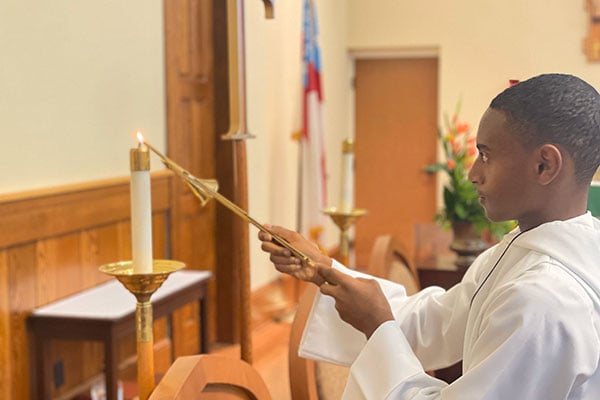
STEM - Science, Technology, Engineering, and Math
Starting in the Primary Division, students participate in weekly direct instruction in the Innovation Lab and engage in various tech-based and unplugged activities that often correspond with concepts they are learning in their classrooms, creating a cross-curricular environment. Students begin using iPads, computers, Osmos, and robots throughout the curriculum. Early in Primary, students focus on learning the four main parts of the computer and how those parts interact with one another, including through the use of circuits, wires, and more. Students use Botley Robots as well as Ozobots to understand how different parts of the robot work, as well as programming concepts including algorithms, sequences, debugging, and loops. These coding concepts are also enforced in their block based coding curriculum in Tynker Jr. and Scratch Jr. and in various unplugged activities. Formal keyboarding begins as early as Kindergarten in Typing Club. Throughout the curriculum, students learn about the QWERTY keyboard and proper finger placement. Additionally, primary students study introductory digital citizenship concepts which enables them to start building a strong foundation in knowledge regarding how to be safe online and create a positive digital footprint. Digital Citizenship concepts covered include media balance, online safety, strong passwords, the internet traffic light, and private information. Once students reach second grade, they begin to learn how to use Gmail for online communication as well as Google Drive where they have the opportunity to create and share projects created in a variety of Google applications. Students in all primary grade levels also learn about the engineering design process and apply these skills through various engineering challenges. These challenges give students the opportunity to develop and build skills around critical thinking, perseverance, creativity, and teamwork.
In the Intermediate Division, students dive deeper into the STEM concepts they have learned in Primary. Coding becomes an even more essential part of the curriculum as students dive deeper into programming in Code.org. Students also begin learning more difficult coding concepts, including functions and conditionals. Students further study age-appropriate digital citizenship concepts including internet research, media balance, keeping games friendly, and how to be safe online. Students engage in projects and activities that enable them to apply their technology knowledge to increase their digital literacy, as well as begin the process of learning how to conduct meaningful and effective Internet-based research. Students learn about AI and Machine Learning as they build their own machine learning projects. Math is integrated throughout the curriculum as students learn about the aforementioned coding concepts as well as binary code, pixels, resolution, and various STEM challenges. Students program robots including Ozobot, Sphero, and Vex. Intermediate students participate in many project based learning activities including a research project surrounding the yearly Global theme, a Battle Bots competition, a video game building project in Bloxels, and the engineering, design, and programming of a robotic arm. Students continue their formal keyboarding skills as they use Typing.com, a self guided typing program. Lessons are broken down by specific keys and rows in order to re-enforce touch typing concepts. Typing.com also offers students the opportunity to type in various programming languages involving the web, including HTML, CSS, and JavaScript. Students are also introduced to Nitrotype, a typing program that allows students to compete and race against their classmates as it tracks their progress. Students in all intermediate grades also continue to apply their knowledge of the engineering design process and apply these skills through various engineering challenges. These challenges give students the opportunity to continue to develop and build skills around critical thinking, perseverance, creativity, and teamwork.
Once students enter Middle School, they engage in project-based learning, where they synthesize technology and computer-based knowledge to complete a variety of assignments. Moreover, students fine-tune their keyboarding skills, as well as further develop their digital citizenship and age-appropriate social media knowledge. By the time our students graduate from eighth grade, they are well prepared with a large spectrum of core technology and computer-related knowledge that they can utilize as they continue their academic careers into high school and beyond.
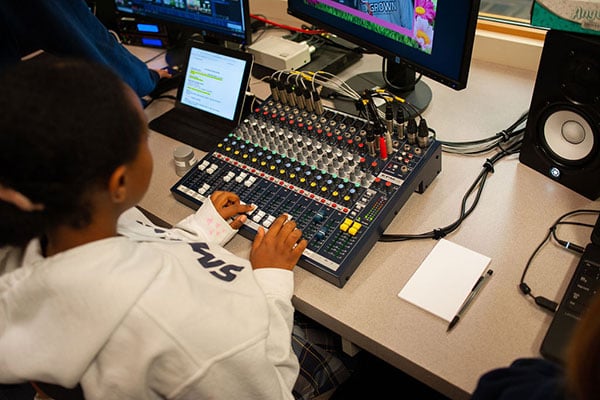
Physical Education
In Pre-Kindergarten, students are introduced to basic locomotor skills such as running, hopping, skipping, jumping, leaping and galloping. We will also work on techniques for balancing, kicking, throwing and catching. Students learn to manipulate equipment individually while also learning how to work in pairs and small groups.
Kindergarten through 2nd grade students learn to demonstrate competency with continued development and mastery of locomotor skills. The introduction of tagging games is a great way to teach speed, agility and spatial awareness while also practicing their locomotor skills. In these grades, emphasis is placed on manipulatives such as hula hoops, beanbags, jump ropes, balls etc. The PE teacher provides opportunities to master these skills through the introduction of organized games and small group work. Within small group games, students learn how to cooperate, share and play with their peers in a positive and encouraging environment.
In 3rd- 5th grades, students have learned how to create and devise strategies in relation to sports and games. They are able to comprehend how strategies along with rules and sportsmanship are interrelated in game play. Game play and fitness continue to enhance cardiovascular strength, muscular strength, and endurance. In these grades, the lead up skills learned in their primary ages, develop into small group and large group games. Continued practice of skills is important at this age, but adding challenges and advanced skills each year keeps the students engaged year-to-year.
Through teaching advanced skills, 6th, 7th, and 8th grade students gain further comprehension of strategies, etiquette, rules, and sportsmanship. They are provided the opportunity to be a part of the wide variety of interscholastic sports. Fitness remains a strong component in middle school P.E. as life long habits in health are promoted.
